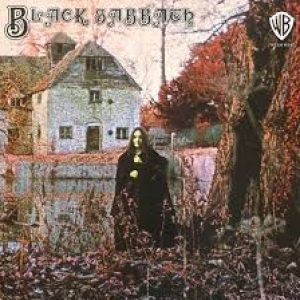Released on February 13, 1970, Black Sabbath by Black Sabbath marked a seismic shift in the landscape of rock music, planting the seed for what would later become heavy metal. This self-titled debut album not only introduced the world to the raw, ominous sounds of the Birmingham quartet, but it also cemented their place in music history. At a time when the psychedelic rock of the late 1960s was still dominant, Black Sabbath diverged from their contemporaries, rejecting the flower power optimism for something darker and more sinister. The album emerged as a reflection of disillusionment, shaped by the industrial bleakness of their hometown and the tumultuous social climate of the time.
Artistic Intentions
Prior to Black Sabbath, the band—then known as Earth—had dabbled in blues-rock, a sound more in line with the burgeoning British scene of the late ’60s. However, with this album, they shifted dramatically toward a heavier, more downtuned style. Their intention was clear: to sonically convey a sense of dread and occult mystery that echoed the horror films that inspired them. The title track itself is an homage to the 1963 horror movie Black Sabbath, setting the thematic tone for the rest of the album.
The artistic intention behind Black Sabbath was to push the boundaries of what rock music could express emotionally and atmospherically. Guitarist Tony Iommi’s detuned riffs, Ozzy Osbourne’s haunting vocals, Geezer Butler’s occult-inspired lyrics, and Bill Ward’s thunderous drumming coalesced to create a new, menacing soundscape. While the band didn’t set out to invent heavy metal, their intention was to offer an antidote to the cheerful psychedelia of the era—an unflinching, doom-laden take on rock that captured the darker realities of life.
Sonic Exploration

The sonic landscape of Black Sabbath is both raw and unapologetically gritty, a reflection of its modest production. Recorded in a single 12-hour session on a shoestring budget, the album’s lo-fi production is integral to its appeal. Producer Rodger Bain worked with the band to capture a live, unpolished sound, allowing the rough edges of the recording to serve the album’s dark, eerie atmosphere. The result is a dense, murky mix that feels as if it’s steeped in shadow, perfectly complementing the album’s themes of fear, doom, and occultism. While some critics at the time dismissed the album’s roughness as amateurish, it is precisely this quality that gives Black Sabbath its primal intensity.
Musical Arrangements
Musically, the arrangements on the album are both minimalist and powerful. Tony Iommi’s downtuned guitar is the driving force behind the record, with his iconic riffs carving out a space for doom-laden heaviness in rock music. Iommi’s decision to detune his guitar—partly influenced by a factory accident that damaged his fingers—added a weighty, sludgy quality to the band’s sound, a defining characteristic of early heavy metal. On tracks like “Black Sabbath” and “N.I.B.,” his riffs crawl and pummel in equal measure, setting a haunting tone that echoes throughout the record.
Ozzy Osbourne’s vocals are stark and emotive, often wavering between a plaintive wail and an unsettling incantation, as heard on the ominous title track. His voice doesn’t overpower the instrumentation but instead becomes another eerie layer within the mix, adding to the album’s foreboding atmosphere. Geezer Butler’s bass, closely intertwined with Iommi’s guitar, provides a thick, rumbling undercurrent, adding depth to the band’s signature sound. Bill Ward’s drumming, with its dynamic swings between thunderous power and jazzy intricacies, showcases the band’s bluesy roots while simultaneously pushing the boundaries of hard rock percussion.
Genre Elements
As for genre elements, Black Sabbath effectively blends several influences to create something wholly new. While rooted in the blues and hard rock traditions, the album veers into previously unexplored territory, fusing elements of doom, psychedelic rock, and nascent heavy metal. The dark, ominous atmosphere of the title track is a sharp contrast to the upbeat experimentation of contemporaries like Led Zeppelin or Deep Purple, signaling a shift toward darker, more oppressive themes. Tracks such as “The Wizard,” with its harmonica riff, hint at their bluesy past, but even this is steeped in a heavier, more brooding tone.
By stripping rock music down to its raw essence and then amplifying its darkness, Black Sabbath forged a new path. The genre-blurring of heavy metal, with its influences from blues, rock, and psychedelia, came into sharper focus on this record, laying the groundwork for countless subgenres in the metal world—from doom to stoner rock to sludge. The album’s sonic grit and eerie minimalism helped to crystallize the emerging identity of heavy metal: heavy, uncompromising, and darkly atmospheric.
Lyrical Analysis

The lyrics on Black Sabbath are steeped in darkness, mysticism, and existential dread, establishing themes that would become central to heavy metal for decades to come. The album’s central themes revolve around fear, the occult, and a deep sense of unease about the unknown, both supernatural and societal. From the foreboding title track to more abstract pieces like “N.I.B.,” Black Sabbath uses their lyrics to explore the darker aspects of human existence, reflecting a world filled with uncertainty and inner turmoil.
The album opens with the title track “Black Sabbath,” where the lyrics describe a chilling encounter with a dark, mysterious figure—likely a reference to Satan himself. This song captures the band’s fascination with the supernatural, expressing themes of fear and helplessness in the face of overwhelming evil. The track’s lines, “What is this that stands before me? / Figure in black which points at me,” create an almost cinematic image of doom, while the repetitive, chant-like structure of the lyrics evokes a sense of impending horror. The use of Satanic imagery, which was both provocative and unsettling for 1970 audiences, taps into a cultural fascination with the occult and the counterculture’s rebellion against traditional religion.
Lyrical Depth
Geezer Butler, who wrote most of the lyrics, imbues them with an aura of poetic simplicity. While not overly complex or abstract, the lyrics manage to convey a profound sense of dread and existential questioning. Songs like “Behind the Wall of Sleep” and “The Wizard” show a mix of narrative storytelling and allegory, referencing arcane or fantastical themes. “Behind the Wall of Sleep” touches on death and the mysteries of the afterlife, while “The Wizard”—despite its fantasy theme—can be interpreted as an ode to inner transformation, with the titular wizard symbolizing a guide through life’s trials.
“N.I.B.” is another key track that stands out lyrically, offering a curious twist on the usual depiction of Lucifer. Rather than simply portraying him as a force of malevolence, the song presents a tale of Satan falling in love and ultimately redeeming himself through that love. The line “My name is Lucifer, please take my hand” is both sinister and oddly vulnerable, suggesting a complexity to the character often missing from standard depictions of evil. Here, the lyrics add a layer of ambiguity to the traditional good-versus-evil dichotomy, allowing for deeper interpretation.
Emotional Impact
Emotionally, the lyrics amplify the album’s mood of dread and alienation. Themes of cosmic evil, spiritual uncertainty, and apocalyptic visions pervade the album, stirring feelings of fear and disquiet in the listener. Even without deeply intricate metaphors, the imagery is potent and evocative, making it easy for audiences to feel the weight of the dark forces described. The starkness of the lyrics, combined with Ozzy Osbourne’s plaintive vocal delivery, creates a haunting, almost hypnotic effect, drawing the listener into the album’s grim world.
Cohesion and Flow

Cohesion is one of the great strengths of Black Sabbath. Despite its relatively short runtime, the album feels like a carefully crafted journey through dark and foreboding soundscapes, with each track contributing to the overall atmosphere of dread and otherworldliness. From the opening notes of the title track to the closing moments of “Warning,” the album maintains a steady progression of tension and release, balancing its heavier moments with bluesy, reflective interludes. Though the songs don’t necessarily form a clear narrative in the traditional sense, there is a strong emotional and thematic continuity that ties the album together.
The album begins with “Black Sabbath,” a nearly six-minute plunge into a slow, doom-laden riff that sets the tone for the rest of the record. This track’s haunting mood establishes an immediate sense of dread, a feeling that reverberates through the album’s subsequent songs. As the tension builds with tracks like “The Wizard,” which adds a slightly more upbeat but still ominous vibe with its harmonica-driven groove, the listener is pulled deeper into the shadowy world the band has constructed.
There’s a natural ebb and flow in the arrangement of tracks that prevents the album from feeling one-dimensional. For example, “Wasp/Behind the Wall of Sleep/Bassically/N.I.B.” introduces a more dynamic structure, with bass-heavy moments of intensity followed by moodier, more restrained passages. These shifts in energy keep the listener engaged while preserving the brooding atmosphere established in the opening track. The progression from slow, crushing riffs to faster, blues-inflected jams ensures that the album doesn’t become monotonous, despite its reliance on dark themes.
Thematic Consistency
From a thematic standpoint, the album stays consistent in its exploration of fear, the occult, and existential uncertainty. Tracks like “Black Sabbath” and “Behind the Wall of Sleep” dive deep into these eerie realms, while even the more upbeat “The Wizard” fits into the larger narrative by evoking a sense of magical mystery. The track “N.I.B.” provides a thematic shift, offering a darker twist on love and redemption through Lucifer’s perspective. However, even this song, with its more romanticized lyrics, doesn’t break the overall atmosphere of foreboding—its riffs and vocal delivery still carry that signature Sabbath heaviness.
Where the album shines in cohesion is in its ability to blend its various influences—blues, psychedelia, and heavy rock—into something that feels unified. The fusion of these styles, while apparent on individual tracks, never feels jarring. This is particularly evident in the closing track “Warning,” a cover of a song by Aynsley Dunbar Retaliation. Though its blues-rock roots are more obvious, Black Sabbath’s treatment of the song is slow-burning and heavy, matching the mood of the original compositions on the album. It brings the record to a satisfying close, reinforcing the thematic undercurrent of paranoia and doom.
Standout Tracks and Moments
Several tracks on Black Sabbath stand out not just for their innovation but for their ability to define the future of heavy music. The album is filled with key moments where the band’s distinctive blend of heaviness, atmosphere, and raw energy crystallizes, marking it as a groundbreaking work. While the album as a whole is essential listening, a few tracks rise above as defining statements of Black Sabbath’s artistic vision.
“Black Sabbath”
Undoubtedly the most iconic track on the album, “Black Sabbath” is a chilling opener that sets the tone for the entire record. From the very first note—the infamous “devil’s tritone” or diminished fifth—this track feels like a descent into darkness. The song’s slow, menacing pace is unlike anything in rock music at the time, making it a revolutionary moment in the birth of heavy metal. What sets “Black Sabbath” apart is its ability to evoke genuine fear through its simplicity: Tony Iommi’s lumbering riff, Ozzy Osbourne’s ghostly wail, and Geezer Butler’s ominous lyrics combine to create a palpable sense of dread.
The track’s most memorable moment comes at the climax, when Ozzy cries out, “Oh no, no, please God help me!” His desperate plea, paired with the song’s crashing crescendo, is one of the most emotionally charged moments in Sabbath’s entire discography. It’s this combination of vulnerability and sonic power that cements “Black Sabbath” as the album’s emotional core.
“N.I.B.”
“N.I.B.” is another standout track, showcasing the band’s ability to fuse heavy, bluesy riffs with imaginative lyrics. Built around a classic Tony Iommi bass line, the song opens with a slow, sludgy groove that soon bursts into a faster, more upbeat rhythm. What makes “N.I.B.” unique is its narrative twist—Lucifer as a protagonist who falls in love, offering a rare humanizing take on a typically malevolent figure.
The standout moment here is the transition from Geezer Butler’s bass solo “Bassically” into the main riff of “N.I.B.,” which bursts with energy and a groove-laden drive. It’s a moment of pure Sabbath brilliance, combining their blues roots with the emerging heavy metal sound, and showing off Iommi’s prowess as a riff master. Ozzy’s vocal delivery, particularly in the chorus, is full of swagger and defiance, adding to the song’s emotional punch.
“The Wizard”
“The Wizard” stands out for its unique fusion of blues, harmonica, and heavy rock. This track, inspired by Gandalf from The Lord of the Rings, brings a mystical element to the album. Bill Ward’s rolling drum work, paired with the harmonica intro, offers an unexpected contrast to the otherwise dark, sludgy atmosphere of the record. It’s a rare moment where the band steps away from doom and instead embraces a more rhythmic, almost celebratory vibe—though it’s still drenched in Black Sabbath’s signature heavy sound.
The harmonica solo, played by Ozzy Osbourne himself, is a surprising highlight. It creates a hypnotic effect that blends perfectly with the heavier instrumentation that follows, adding a layer of groove and texture that makes “The Wizard” one of the most dynamic tracks on the album.
“Behind the Wall of Sleep”
Though often overshadowed by the album’s more famous tracks, “Behind the Wall of Sleep” is a gem. Lyrically dealing with death and the transition between life and the afterlife, it taps into one of the album’s central themes—fear of the unknown. Musically, it features a more energetic, riff-heavy structure, with Bill Ward’s jazzy drumming providing a fluid rhythm. The midsection, where Tony Iommi’s guitar work takes on a more improvisational feel, is a standout moment, showing off his ability to blend technical skill with raw emotional intensity.
Memorable Moments
One of the album’s most memorable moments happens in the middle of “Black Sabbath” when the stormy intro subsides and Ozzy’s haunting vocals fill the void. His vocal delivery—calm, almost detached at first, before becoming more desperate—makes this one of the most haunting vocal performances in rock history. Another moment that captures the essence of the album is the instrumental breakdown in “Warning,” where Iommi’s guitar soloing takes on a life of its own, stretching out over several minutes in a sprawling, blues-infused showcase of his technical skill and improvisational prowess.
Lastly, the closing moments of “Warning” offer a perfect summation of the album’s mood, as the song fades out with a slow, crushing riff that leaves the listener in a state of reflection. It’s a final, lasting reminder of the bleak, otherworldly journey that Black Sabbath has taken us on.
Artistic Contribution and Innovation

Black Sabbath stands as a monumental turning point in the history of rock music, widely regarded as the genesis of heavy metal. At the time of its release in 1970, rock was still largely dominated by blues-based hard rock, folk-rock, and the remnants of the psychedelic movement. Black Sabbath, with its dark, brooding atmosphere and crushing riffs, broke away from these conventions, laying the foundation for a new genre that would eventually splinter into numerous subgenres like doom metal, sludge, and stoner rock. This album’s contribution to both its genre and the wider music industry cannot be overstated—it was a decisive rejection of the peace-and-love ethos of the 1960s, instead embracing themes of fear, existential dread, and the supernatural.
Place in Genre/Industry
At the time of its release, Black Sabbath was truly unlike anything else in the rock scene. Bands like Led Zeppelin, Deep Purple, and Cream were blending blues, jazz, and psychedelia into heavier rock forms, but Sabbath took this a step further by stripping away much of the complexity and injecting a raw, primal heaviness that relied on slow, detuned guitar riffs and dark, unsettling lyrical themes. In doing so, they invented a sound that was, by all measures, the birth of heavy metal. The album’s slow tempos, minor key progressions, and foreboding atmosphere distinguished it from the high-energy, bluesy rock of the day.
What’s most striking about Black Sabbath in terms of its genre impact is its unapologetic embrace of the macabre and occult, themes that were rarely, if ever, explored with such seriousness in rock music. While some bands dabbled in darker themes (such as The Doors or The Velvet Underground), Sabbath’s commitment to creating a pervasive sense of dread and mystery through their music and lyrics was unprecedented. This thematic shift—away from love, rebellion, or mysticism and toward horror and doom—carved out a new narrative space within rock, one that would heavily influence bands from Metallica to Slayer, and beyond.
Innovation
Perhaps the album’s most innovative feature is its sound—particularly Tony Iommi’s downtuned guitar playing, which added a new layer of heaviness to rock music. Iommi’s decision to detune his guitar to ease the pain caused by an accident that cost him two fingertips inadvertently gave the band a sludgy, darker tone that became one of the key sonic signatures of heavy metal. This downtuned, distorted guitar sound, combined with Iommi’s pioneering use of power chords and riff-based song structures, set the blueprint for countless metal bands in the decades that followed.
Structure
Another innovative aspect of Black Sabbath is its approach to rhythm and structure. Where much of rock at the time relied on upbeat, fast-paced rhythms, Sabbath often slowed things down, creating a feeling of impending doom with long, sustained notes and deliberate pacing. Tracks like “Black Sabbath” and “N.I.B.” crawl forward with a weighty slowness that had rarely been heard in rock, but would go on to inspire entire subgenres of metal, including doom metal and stoner rock. Bill Ward’s drumming, which often incorporates jazzy fills and unconventional time signatures, also played a key role in giving the album a unique groove that set it apart from the frenetic rock rhythms of the day.
Themes
In terms of thematic innovation, Black Sabbath broke new ground by weaving elements of horror into its lyrics and atmosphere. This wasn’t just superficial imagery—Geezer Butler’s lyrics often explored themes of existential dread, the battle between good and evil, and the fear of the unknown. Songs like “Black Sabbath” and “Behind the Wall of Sleep” tap into primal fears in a way that had rarely been done in rock before. By embracing these themes, Sabbath connected their music with the darker aspects of human consciousness, making the album resonate on a deeper psychological level.
Moreover, their use of horror as a thematic element influenced not only metal but other genres like goth rock and industrial music, where bands like Bauhaus, Sisters of Mercy, and Nine Inch Nails would also explore darkness, fear, and alienation in their own ways.
Closing Thoughts

Black Sabbath is not just an album—it’s a seismic event in the history of music. Its strengths lie in its groundbreaking combination of dark, atmospheric themes and innovative musical techniques, most notably Tony Iommi’s downtuned guitar riffs and the band’s unrelenting exploration of fear, doom, and the supernatural. The raw production adds to its mystique, making the album feel almost primal in its power. Each member of the band brought something essential: from Ozzy Osbourne’s haunting, desperate vocals to Bill Ward’s dynamic drumming and Geezer Butler’s eerie, occult-driven lyrics. Together, they crafted an album that redefined the boundaries of rock and gave birth to heavy metal.
In terms of weaknesses, the only criticism might be its lack of polish. The lo-fi production, while now iconic, may come across as rough to modern listeners used to crisper, more refined recordings. However, this “flaw” ultimately becomes a strength when viewed in the context of the album’s artistic vision—it adds to the sense of raw energy and unfiltered emotion that makes Black Sabbath so impactful.
The album’s legacy is undeniable. It not only launched the career of Black Sabbath but also set the stage for an entire genre that would evolve into countless subgenres, each owing a debt to this singular work. For listeners, Black Sabbath offers an immersive experience—an invitation to confront existential fears through the power of sound. Even over 50 years later, the album still resonates with its oppressive, doomy atmosphere and timeless exploration of humanity’s darker instincts.
Official Rating
Given its monumental influence, innovation, and the sheer emotional weight it carries, Black Sabbath deserves a perfect 10. While it may not be flawless in a technical sense, its imperfections only add to its charm and character. The album was a bold, fearless creation that redefined what rock music could be, pushing boundaries not just in terms of sound, but in the themes it dared to explore. Few albums have had such a lasting impact on music and culture. With its haunting atmosphere, groundbreaking guitar work, and dark lyrical themes, Black Sabbath is a masterpiece that continues to shape the world of heavy music, earning its place as one of the most important albums in rock history.
